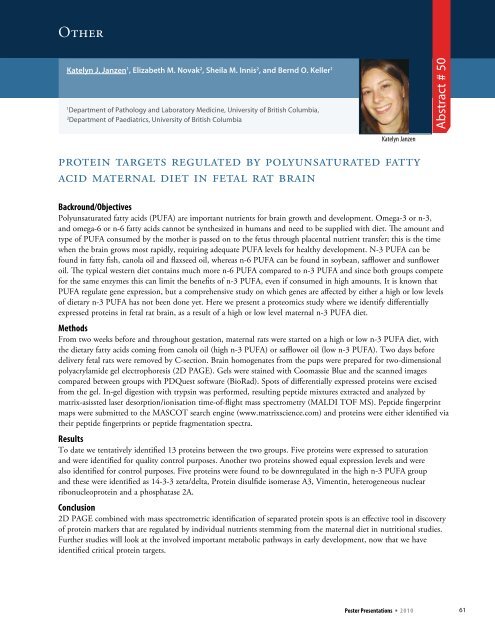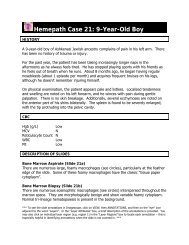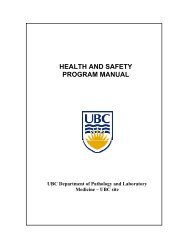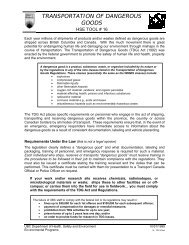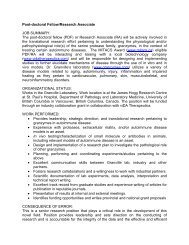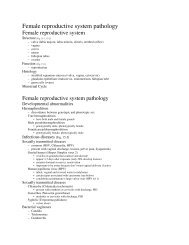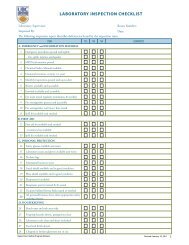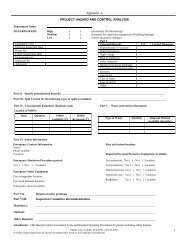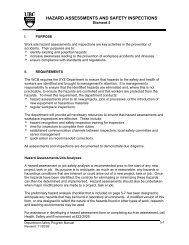Oral Presentations - Pathology and Laboratory Medicine - University ...
Oral Presentations - Pathology and Laboratory Medicine - University ...
Oral Presentations - Pathology and Laboratory Medicine - University ...
Create successful ePaper yourself
Turn your PDF publications into a flip-book with our unique Google optimized e-Paper software.
OtherKatelyn J. Janzen 1 , Elizabeth M. Novak 2 , Sheila M. Innis 2 , <strong>and</strong> Bernd O. Keller 11Department of <strong>Pathology</strong> <strong>and</strong> <strong>Laboratory</strong> <strong>Medicine</strong>, <strong>University</strong> of British Columbia,2Department of Paediatrics, <strong>University</strong> of British ColumbiaAbstract # 50Katelyn Janzenprotein targets regulated by polyunsaturated fattyacid maternal diet in fetal rat brainBackround/ObjectivesPolyunsaturated fatty acids (PUFA) are important nutrients for brain growth <strong>and</strong> development. Omega-3 or n-3,<strong>and</strong> omega-6 or n-6 fatty acids cannot be synthesized in humans <strong>and</strong> need to be supplied with diet. The amount <strong>and</strong>type of PUFA consumed by the mother is passed on to the fetus through placental nutrient transfer; this is the timewhen the brain grows most rapidly, requiring adequate PUFA levels for healthy development. N-3 PUFA can befound in fatty fish, canola oil <strong>and</strong> flaxseed oil, whereas n-6 PUFA can be found in soybean, safflower <strong>and</strong> sunfloweroil. The typical western diet contains much more n-6 PUFA compared to n-3 PUFA <strong>and</strong> since both groups competefor the same enzymes this can limit the benefits of n-3 PUFA, even if consumed in high amounts. It is known thatPUFA regulate gene expression, but a comprehensive study on which genes are affected by either a high or low levelsof dietary n-3 PUFA has not been done yet. Here we present a proteomics study where we identify differentiallyexpressed proteins in fetal rat brain, as a result of a high or low level maternal n-3 PUFA diet.MethodsFrom two weeks before <strong>and</strong> throughout gestation, maternal rats were started on a high or low n-3 PUFA diet, withthe dietary fatty acids coming from canola oil (high n-3 PUFA) or safflower oil (low n-3 PUFA). Two days beforedelivery fetal rats were removed by C-section. Brain homogenates from the pups were prepared for two-dimensionalpolyacrylamide gel electrophoresis (2D PAGE). Gels were stained with Coomassie Blue <strong>and</strong> the scanned imagescompared between groups with PDQuest software (BioRad). Spots of differentially expressed proteins were excisedfrom the gel. In-gel digestion with trypsin was performed, resulting peptide mixtures extracted <strong>and</strong> analyzed bymatrix-asissted laser desorption/ionisation time-of-flight mass spectrometry (MALDI TOF MS). Peptide fingerprintmaps were submitted to the MASCOT search engine (www.matrixscience.com) <strong>and</strong> proteins were either identified viatheir peptide fingerprints or peptide fragmentation spectra.ResultsTo date we tentatively identified 13 proteins between the two groups. Five proteins were expressed to saturation<strong>and</strong> were identified for quality control purposes. Another two proteins showed equal expression levels <strong>and</strong> werealso identified for control purposes. Five proteins were found to be downregulated in the high n-3 PUFA group<strong>and</strong> these were identified as 14-3-3 zeta/delta, Protein disulfide isomerase A3, Vimentin, heterogeneous nuclearribonucleoprotein <strong>and</strong> a phosphatase 2A.Conclusion2D PAGE combined with mass spectrometric identification of separated protein spots is an effective tool in discoveryof protein markers that are regulated by individual nutrients stemming from the maternal diet in nutritional studies.Further studies will look at the involved important metabolic pathways in early development, now that we haveidentified critical protein targets.Poster <strong>Presentations</strong> * 2 0 1 061


